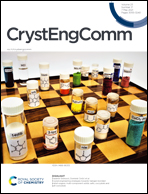1D ladder and 2D bilayer coordination polymers constructed from a new T-shaped ligand: luminescence, magnetic and CO2 gas adsorption properties†
Abstract
A new three-connecting T-shaped ligand, (4-3′-pyridyl-,6-4′-carboxylphenyl)picolinic acid (H2L), was used to construct four coordination polymers: {[Mn(L)(H2O)2]·2H2O}n (1), {[Cd(HL)(Cl)]·0.5H2O}n (2), [Co(L)(H2O)]n (3) and {[Ni(L)(H2O)2]·1.5H2O}n (4). Based on this T-shaped ligand, one 1D ladder chain (1) and two unique 2D bilayers (2 and 3) were constructed. Regardless of the three-connecting L2− ligand, 4 only consists of an infinite 2D network, in which two L2− ligands bridge two NiII centres, leading to a rhombic grid motif that is further connected to four adjacent rhombic grids, resulting in a 2D polymeric network. Interestingly, both 2 and 3 possess rhombic voids and exhibit CO2 gas adsorption features. Because coordination polymer 2 possesses a larger pore size (11.60 × 7.86 Å)/volume (16.7%) than that of 3 (11.53 × 7.65 Å/10.2%), 2 exhibits higher CO2 adsorption capacities at 273 K. Furthermore, the magnetic properties and photoluminescence have also been investigated. The present work provides a promising approach to design a new T-shaped ligand and construct various coordination polymers or metal–organic frameworks, and then to tune CO2 adsorption properties.

- This article is part of the themed collection: Coordination Networks


 Please wait while we load your content...
Please wait while we load your content...